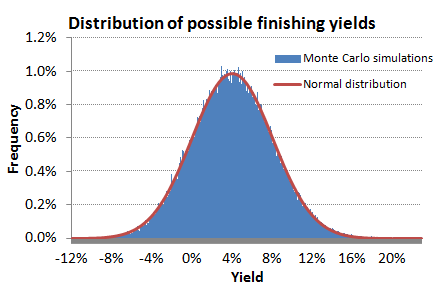Wisdom of the Crowd: 2015/16 performance
Posted 17th May 2016
In August 2015, I published an article describing a possible football betting system based on the Wisdom of the Crowd. The methodology assumes that the Pinnacle Sports football match betting market (1X2) offers the most efficient (accurate) prices, which once adjusted for the margin and the favourite-longshot bias, should provide reasonable estimates for fair odds. Consequently, where other bookmakers are found to be offering longer prices, the presumption is that these represent betting value. The nature of the system allows the user to calculate expected value for every bet and hence the expected average advantage held over the profit line. Each week this season I have been posting suggested betting tips based on this methodology. Specifically, I have posted suggestions where implied value has been over 2%, although users are always free to use whatever value threshold they choose. This article looks at how the system has performed relative to the three previous seasons which were used to test the methodology retrospectively.
The four tables below show how each season has performed for over-2%, over-3%, over-4% and over-5% value thresholds respectively. Predictably, as we demand increasingly higher value in our bets, the number of possible matches available to us gets smaller. You will notice that there are considerably fewer bets for the 2015/16 season compared to previous years. 2015/16 tips have been posted in real time, and I have missed several weekends on account of absence. Additionally, I did not begin posting the tips until mid August and have chosen to cease tips for the remainder of this season now that all the major leagues have finished. In contrast, the three previous years all contain back-tested data for the entire July to June seasons.
Each table shows both the actual yield achieved and the expected yield as predicted from the methodology calculation.
Bets with over 2% Implied Value
| Season |
Bets |
Actual Yield |
Exp Yield |
| 2012/13 |
2795 |
6.71% |
4.14% |
| 2013/14 |
2935 |
6.27% |
4.01% |
| 2014/15 |
3466 |
6.88% |
3.98% |
| 2015/16 |
1675 |
0.40% |
4.07% |
Bets with over 3% Implied Value
| Season |
Bets |
Actual Yield |
Exp Yield |
| 2012/13 |
1704 |
6.24% |
5.22% |
| 2013/14 |
1746 |
15.46% |
5.07% |
| 2014/15 |
2024 |
5.27% |
5.07% |
| 2015/16 |
995 |
2.81% |
5.19% |
Bets with over 4% Implied Value
| Season |
Bets |
Actual Yield |
Exp Yield |
| 2012/13 |
1026 |
10.06% |
6.39% |
| 2013/14 |
1069 |
22.58% |
6.10% |
| 2014/15 |
1148 |
5.85% |
6.31% |
| 2015/16 |
606 |
4.15% |
6.29% |
Bets with over 5% Implied Value
| Season |
Bets |
Actual Yield |
Exp Yield |
| 2012/13 |
622 |
17.09% |
7.66% |
| 2013/14 |
637 |
25.55% |
7.22% |
| 2014/15 |
668 |
-2.14% |
7.66% |
| 2015/16 |
357 |
6.89% |
7.55% |
A number of broad observations can be made from these results.
- The smaller the sample sizes (for increasingly larger value thresholds), the greater the variance in actual yields from season to season, and the greater the differences between actual and expected yields. This is entirely predictable and is a consequence of the law of large numbers. [Just think of tossing a coin 10 times, 100 times and 1,000 times.]
- Seasons 2012/13 through 2014/15 have broadly outperformed expectation, whilst season 2015/16 has underperformed. Assuming the methodology is working as it should, these deviations will have arisen simply as a consequence of chance.
- In all seasons the higher the value threshold the better the actual performance (yield). This is a sign that the methodology is working as it is predicted to.
More specifically, it is worth asking just how poor a performance 2015/16 for the over-2% value threshold proved to be relative to expectation, and whether it's a sign that something is wrong. We can provide an answer by running a Monte Carlo simulation which allows us to investigate the distribution of theoretically possible yields based on our betting history. I have described the general approach to the Monte Carlo Method in my article for Pinnacle Sports, which includes details of how to perform the analysis in Excel. My simulation here has produced 100,000 different possible finishing yields, shown in the distribution below (at 0.1% yield intervals). You can see clearly that this distribution is essentially normal, as would be expected given the way the yields are generated (by means of an random number generator).

You can see clearly from the distribution that despite holding a theoretical advantage of over 4%, a sizeable percentage of theoretical yields fall below 0%. In fact the figure is 15.7%. 81.8% of the time we would expect our performance to be better than the actual yield of 0.4% given the number of bets in the sample and the odds they had. This is well within the realms of good and bad luck as defined by statisticians, so we should not abandon our system as one that is no longer working. Furthermore, the performances at the higher value thresholds are closer to expectation and should give us confidence to continue with this methodology throughout the following season.
|





